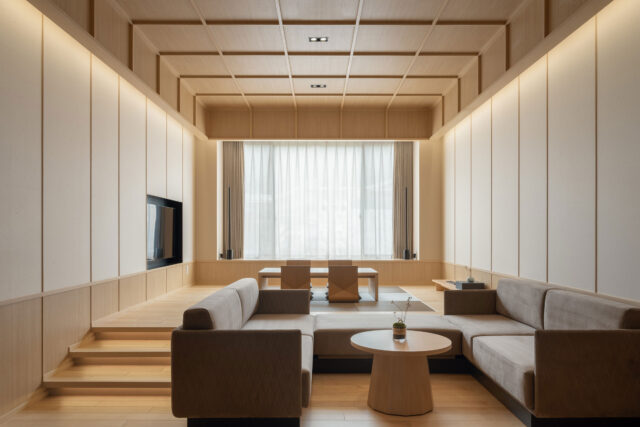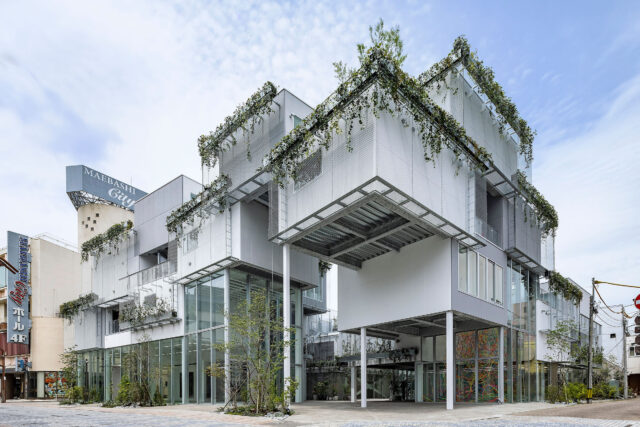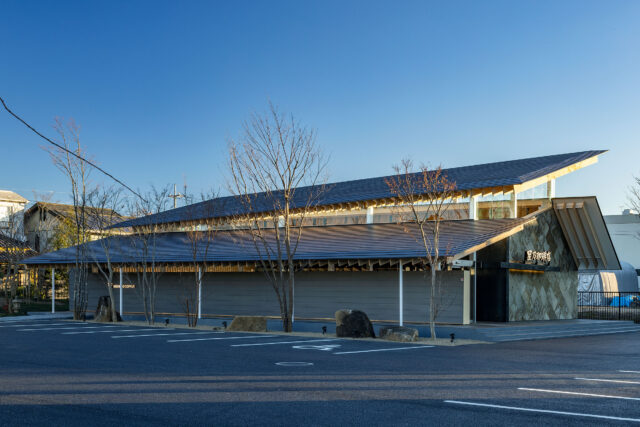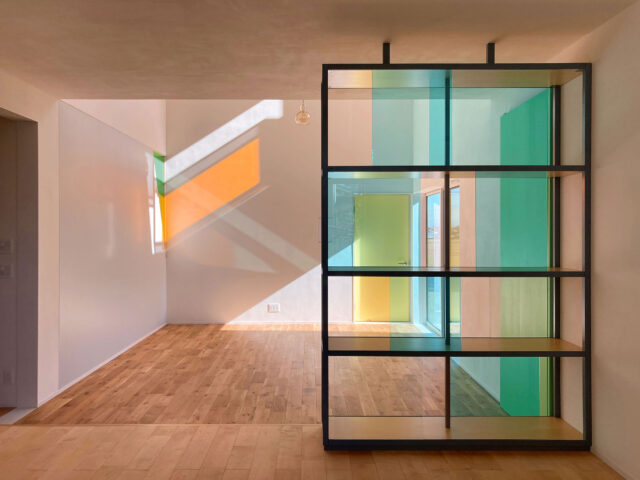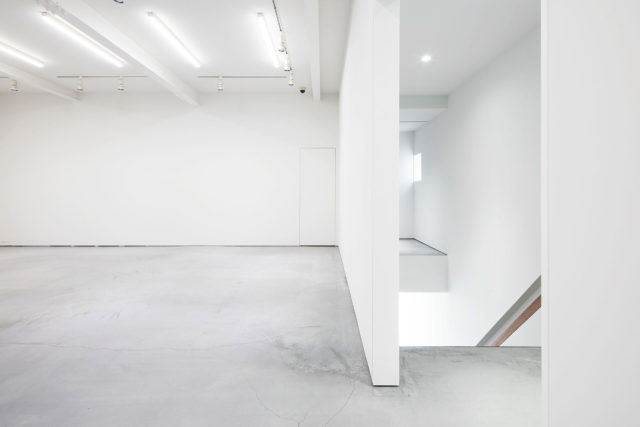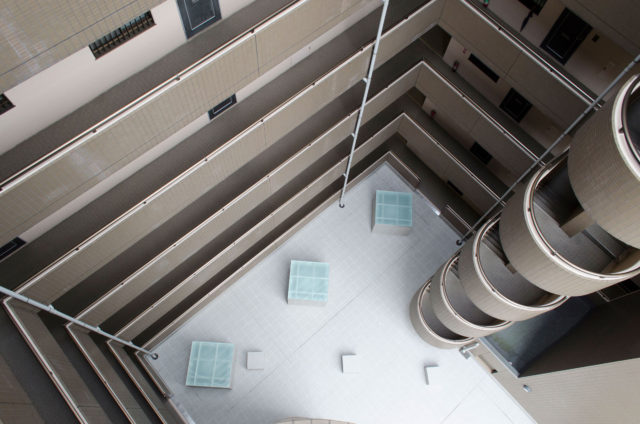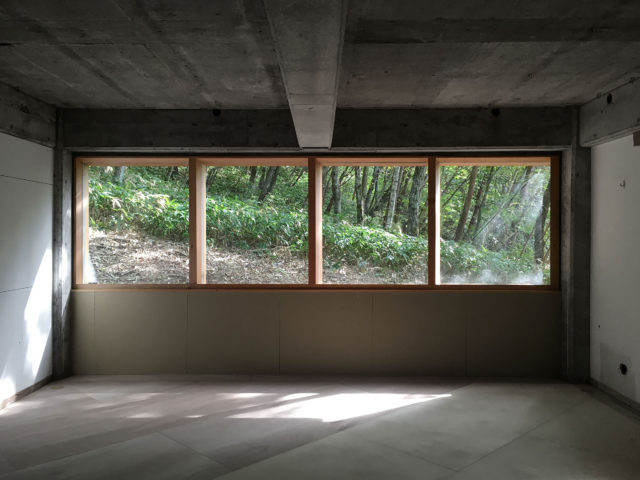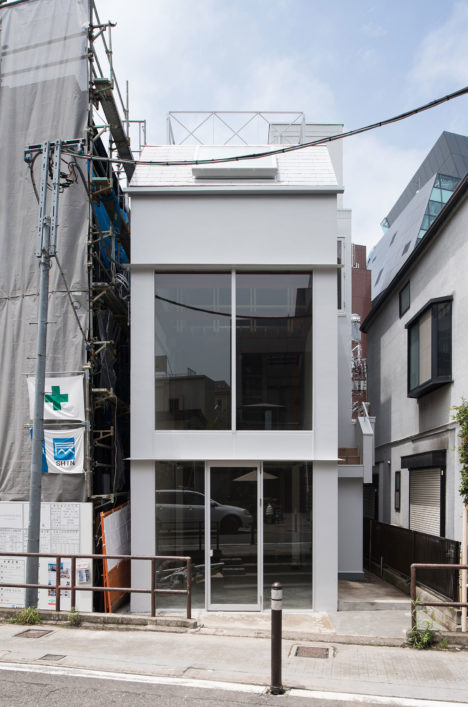
SHARE 園田慎二建築設計事務所による、東京の「揺らめく部屋」。戸建住宅の二部屋を繋げてワンルームへと改修する計画。自由な生活に繋がる“軽やかさ”を求め、“浮遊するような建築的な設え”で作る空間を志向。様々な要素を“天井からワイヤーで吊る”方法で据え付ける



園田慎二建築設計事務所が設計した、東京の「揺らめく部屋」です。
戸建住宅の二部屋を繋げてワンルームへと改修する計画です。建築家は、自由な生活に繋がる“軽やかさ”を求め、“浮遊するような建築的な設え”で作る空間を志向しました。そして、様々な要素を“天井からワイヤーで吊る”方法で据え付けました。
都内の閑静な住宅地に建つ住まいの、1階の2部屋をつなげ、キッチンとダイニングスペースと、寝室が合わさった40㎡程のワンルームへ変える改修計画である。
部屋の3面の壁は開口部があり、その先には、隣家の庭や、手入れされた和風の庭が広がり、時間によってきれいな自然光も入り込む。この場所に対して、環境を透し、時に移ろい、定まらない揺らぎのある要素として、軽やかで、浮遊するような建築的な設えを考えた。揺らいでいるような軽さのある室内が、自由な生活や、魅力的な庭へのまなざしへと繋がる。
床や壁や天井からがっしりと固定されているのではなく、触れたら少し動き、また元の位置に戻るくらいの、そのような定着しない建築として間仕切や棚のエレメントをつくった。風を受ければ少しなびくように、建築エレメントが空間を漂う。
以下の写真はクリックで拡大します
























以下、建築家によるテキストです。
都内の閑静な住宅地に建つ住まいの、1階の2部屋をつなげ、キッチンとダイニングスペースと、寝室が合わさった40㎡程のワンルームへ変える改修計画である。
部屋の3面の壁は開口部があり、その先には、隣家の庭や、手入れされた和風の庭が広がり、時間によってきれいな自然光も入り込む。この場所に対して、環境を透し、時に移ろい、定まらない揺らぎのある要素として、軽やかで、浮遊するような建築的な設えを考えた。揺らいでいるような軽さのある室内が、自由な生活や、魅力的な庭へのまなざしへと繋がる。
床や壁や天井からがっしりと固定されているのではなく、触れたら少し動き、また元の位置に戻るくらいの、そのような定着しない建築として間仕切や棚のエレメントをつくった。風を受ければ少しなびくように、建築エレメントが空間を漂う。
棚板は、通常であれば壁に控えをとり、しっかりと固定できるが、ここでは、天井からワイヤーで吊るされている。棚受け金具はなく、代わりに棚板は複数本のワイヤーで天井からぶら下がっている。パーティションも天井と床に張られたワイヤーによって宙に浮く。ピンと張ったワイヤーによってしっかりと固定されているが、ちょっと手で触れたり、風を受けると、ブルブルっと振動して、そしてまた元の定位置に戻る。
クローゼットも天井からつられている。透過性の高いカーテンは、その裏にぶら下がる洋服のシルエットを映しだすが、ハンガーパイプを支える支柱や受け金具は見当たらない。食器棚は、床との間に丸太を挟み、その丸太が支点となり、もう片方はワイヤーで吊り上げた。床と食器棚の間には100mm程の隙間が広がる。窓に設けられた簾やカーテンも、天井側からつられている。そのように、床や壁に“固定しない”、“触れているだけ”のつくりである。
生活の変化に応じて、吊られた建築エレメントは、金具の位置を変えることができ、長期的・機能的な柔軟性がある。同時に、吊られている、という軽やかなエレメントが織りなす空間は、定着されていない浮遊感が漂う、揺らぎのある部屋である。
■建築概要
所在地:東京都
主要用途:専用住宅
設計:園田慎二建築設計事務所
施工:田工房
計画面積:40㎡
設計期間:2023年7月~2023年12月
工事期間:2023年12月~2024年2月
写真:木暮伸也
| 種別 | 使用箇所 | 商品名(メーカー名) |
|---|---|---|
| 内装・床 | 床 | カーペット:MANYO HANEZU(オリエンタルカーペット) |
| 内装・建具 | 簾 | |
| 内装・建具 | 浮き障子 | 桟・カマチ・組子:ヒノキ(中井産業) |
| 内装・建具 | カーテン | |
| 内装・金物 | 棚などのワイヤー金物 | アラカワグリップ MH-3 2000 white |
※企業様による建材情報についてのご意見や「PR」のご相談はこちらから
※この情報は弊サイトや設計者が建材の性能等を保証するものではありません
The house is located in a quiet residential area in Tokyo. The renovation project involved connecting two rooms on the first floor and converting them into a single room of about 40 m2 with a kitchen, dining space and a bedroom.
Three walls of the room have windows that open onto the neighbor’s garden and a well-kept Japanese-style garden. Beautiful natural light also enters during certain hours of the day. For this location, we considered a light, floating architectural setting that transmits the surrounding environment and is composed of elements that sometimes fluctuate and change. The fluctuating lightness of the interior gives a sense of freedom in life and visually connects the room to the attractive gardens.
The architectural elements, such as partitions and shelves, were designed to move slightly when touched and return to their original positions rather than being firmly fixed to the floor, walls, or ceiling. They drift in the space as if gently fluttering in the wind.
Typically, shelves are securely fastened to the wall with brackets. But here, they are suspended from the ceiling with wire. Instead of using shelf brackets, the shelves are suspended from the ceiling with multiple wires. The partitions are also suspended mid-air with wires strung across the ceiling and floor. They are firmly fixed with taut wires, but when touched gently by hand or blown by the wind, they vibrate and then return to their original positions.
The closet also hangs from the ceiling. The highly translucent curtains reflect the silhouettes of the clothes hanging behind them, but there are no posts or receiving brackets for the hanger pipe. The cupboard rests on a log inserted between it and the floor that serves as a fulcrum, and the other end is suspended with wires. There is a 100 mm gap between the floor and the cupboard. The blinds and curtains at the windows all hang from the ceiling. In this manner, all elements are not “fixed” to the floor or walls but only “in contact” with them.
The position of the metal fittings of the suspended architectural elements can be changed according to changes in life, allowing for long-term and functional flexibility. At the same time, the space in which the suspended, light elements are woven together constitutes a fluctuating room with a floating feeling that is not fixed in place.
Fluctuating Room
Location: Tokyo, Japan
Primary use: Private residence
Architect: Shinji Sonoda & Associates
Contractor: Den Koubou
Planned area: 40m2
Design period: July–December 2023
Construction period: December 2023–February 2024
Photographer: Shinya Kigure

